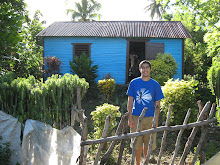

July 4 in the DR. Peace Corps Volunteers. How do you envision this? I am curious to find out how things like this go in other countries. For us, we had a beach party. Fully half of the volunteers here took a bus 8 hours from the capital to the border with Haiti to a deserted beach in a national park called Bahia de las Aguilas (Eagle Bay). For the first time in known history, the park did not let volunteers spend the night at the beach. This is because it is turtle nesting season. You might say, well, don’t turtles nest at the same time every year? The answer is yes, but the park only decided to enforce its rules this year, possibly because of capacity building due to a volunteer being placed at the park. Still a good time, and absolutely beautiful.
I have finally moved into my new house. Specs: Tin roof, wooden walls, two bedrooms, living room, kitchen, no running water, latrine, two light bulbs, four windows (window means angled wooden slats), rickety gazebo, baths taken outside or at neighbor’s. I repainted the whole thing except the kitchen (which is white) bright blue, and the windows brown. I live with dozens of lizards, the occasional tarantula or cockroach, any number of spiders, and hundreds of mosquitoes. No rats. Visitors welcome.

When I was in Spain, people my age called each other “tío” and sometimes “tía.” Literally, uncle and aunt, this roughly translated as “dude.” Tío doesn’t fly here. Like “vale,” (meaning OK), it just confuses them, and I dropped the habit. But what to call my friends besides their names? This has been my quest since I got here, among others. I think that I have picked up on something, the terms “tipo” and “sujeto” and their feminine counterparts. Literally type and subject, they seem to roughly correlate to “guy/gal” and “dude/man.” “Tipo” is never used to call someone, just to refer to them. For example: “Este tipo estaba dando la muela a mi mujer, entonces le dí una galleta.” More or less meaning “This guy was hitting on my girl, so I hit him.” To call one another, people say “sujeto,” as in “Que lo que sujeto,” roughly “Whats up, dude.” All this is based on the four Dominican males my age who I hang out with; everyone else is over 40 with kids or 13. So they could have made all of this up.
Speaking of word choice, I’ve always been interested in place names. At home, they are all named after dead Indians or something nauseatingly bucolic. At least they sounded nice. Here, at least in my area, they tend to be much more literal. Many villages are nature-themed. My village and the neighboring one are both named after endemic trees, and there are other, more familiar fruit and tree names: Mahogany, The Almond Trees, The Limes, The Palm Trees, Fresh Mango, Coconut Number One and Coconut Number Two, among others. Water themes are also very popular: Coldwater, Headwater, Dry Stream, Beautiful Stream, Big Stream, Clear Canal and Little Lake. Other geographic features are often used, like Narrow Plain, Rock Heights, The Caves, Summit, Mountain Plain, and Inner Mountain. Agriculture is big here, so there are places called Ranch, Upper Ranch, Farm, St. Joseph of the Farm, Farmyard Hill, and Goat Heights. There are colors: Orange, The Blues, Upper White, Lower White, Middle White, and Little Whites. Finally, the self-explanatory and most interesting: Snake, Pleasure, and Death.


2 comentarios:
ok so firstly i should have been mentioned as the color consultant for your house. secondly, to hit someone is to "give a cookie"? interesting.
Publicar un comentario